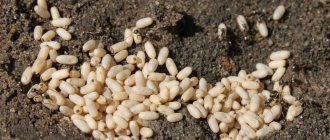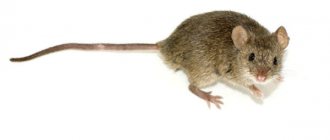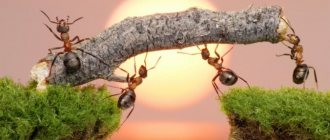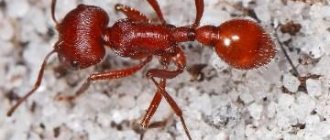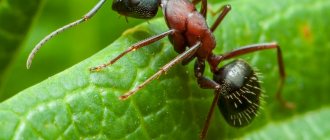Benefits in nature
It’s not for nothing that the ant is called the forest orderly. It accelerates the decomposition of rotten wood, collects dry leaves and branches, and cleans plants of caterpillars, mites, and sawflies. The insect may cause harm, but it also performs many useful functions.
Benefits in soil formation
Arthropods loosen the soil better than worms. They dig holes at a depth of 70 cm, while worms do not penetrate the soil below 20 cm. The soil is mixed and enriched with the following substances:
This improves the growth and development of plants. You may notice that the vegetation around anthills is denser and healthier.
Few people know why ants are needed in the forest and fields. But their benefits here are invaluable - they are the ones who loosen the earth, filling it with air and nutrients.
A lot of excrement accumulates around anthills, which serves as fertilizer for vegetation.
Benefits in clearing forests
Rotten stumps become a haven for ants. They build a nest there and speed up the decomposition process of the dead tree. Forest ants, during the construction of their home, collect leaves, branches, blades of grass and pine needles from the surrounding area.
In an anthill, the decomposition of grass and wood particles occurs faster than in air. This is due to the fact that there is higher temperature and humidity, as well as a unique microflora with its own bacteria and fungi.
Benefits for plants
The benefits of ants in nature are enormous. They spread seeds throughout the forest. About 3,000 plant species are spread by industrious insects. Including:
- fragrant violet;
- celandine;
- goose onion;
- corydalis;
- thyme;
- hairy hairy
All these herbs and flowers cannot grow without ants, who carry their seeds into the house, losing some along the way.
The following plants are carried exclusively by ants:
- violet;
- hoof;
- woodland and other myrmecochoreous plants.
Some types of ants love to feed on sweet pollen and thus can help pollinate flowers.
Benefits in pest control
Arthropods cleanse the forest of dead insects and pests. It is known that moths and sawflies destroy plants and thereby cause enormous damage to the forest. But where there is an anthill, the number of these pests is small.
If there are few ants in the forest, then foresters specially populate these beneficial insects. One anthill per day can clear the surrounding area of 2000 larvae and pupae of various pests.
Link in the food chain
Here, too, there is no benefit from ants. Songbirds and some animals hunt insects:
Birds love to bathe their feathers in ants. In this way they get rid of pests. Some scientists are sure that birds are also treated with ants, crushing them under their wings. After all, formic acid benefits the body.
Little worker
All of us, surprised and admiring, watch how a tiny ant drags prey into its house, many times larger than itself . Everyone will envy their hard work and endurance. What is the role of ants in nature?
Beneficial activities of ants
Unexplored paths of little workers
How are ants useful? These insects are associated with a secret society. For millions of years, exchanging an encrypted language, they pave paths unknown to anyone. We are just beginning to know them today. At first glance, the activities of ants seem chaotic and useless . But is it? What benefits do ants bring to the forest and people?
Tiny soil formers
In the process of building their nests, ants loosen the soil, providing more air access to the roots of plants. But this favors their breathing.
This is especially necessary in places where there are heavy clay soil layers.
For example, an earthworm is active up to 20 cm deep, and a garden ant builds an underground house up to one and a half meters deep in 2-3 years with excellent aeration and humidity of more than 90%.
It is reliably known that thanks to the activity of these insects, the amount of potassium in the soil doubles, and phosphorus becomes ten times more. At the same time, it is they who promote the transition of these substances from an insoluble state to a soluble state available for plant nutrition.
Moreover, these insects enrich the soil with substances such as humus, potassium, nitrogen, improving its structure and increasing fertility.
The benefits of ants in seed dispersal
Small seed spreaders
Ants don't just make trails in search of food and building material for their castles. The ant crawls usefully. Do you know what benefits they have in expanding the flora? About 1% of plants, which is approximately 3,000 species, are spread by these insects.
Celandine, hairy gooseberry, goose onion, thyme, corydalis and many others are equipped with special appendages on their seeds that ants love to feast on. Carrying this delicacy home, they spread the seeds several tens of meters around . By the way, only ants spread fragrant violets.
Ant - forest orderly
By destroying dead insects, ants can rightfully be called nurse insects.
Insect nurses
In the forest where anthills are located, there are no outbreaks of mass reproduction of insect pests: sawflies, spider mites, cutworms, slugs.
A medium-sized garden anthill can collect up to 2000 larvae, eggs, caterpillars and other pests in one day . During the same period, the inhabitants of one forest anthill are able to eat more than 17,000 insects, protecting an area of 0.2 hectares.
Nebaiduzha detail of a forest landscape
Murakhi are forest nurses. It’s not for nothing that they are called that. The creepiness in the forest is on a global scale. Instantly following various kinds of larvae on the trees of the goosebump, the stinkers steal the forest from their massive reproduction.
In addition, the goosebumps affected by the disease do not disappear from the goosebumps, but die on their own.
Ant hydrometeorological center
Another feature that can be usefully used by people and borrowed from these insects is the ability to anticipate weather changes. They feel the storm. The day before they go into the anthill and close all the passages .
Ants as prey
The importance of ants in nature is not limited to their activities. They can benefit by sacrificing themselves. What are ants for?
Nutritious food for birds
Ants are food for forest dwellers
Ants are an important link in the food chain. They are a favorite treat for songbirds and badgers. Bears, foxes, black grouse, and hazel grouse feed on them.
Birds “bathe” in anthills, launching insects under their wings and crushing them on their feathers. In this way they eliminate parasites, and, possibly, are cured with formic acid .
Medicine for humans
Modern medical research has proven that many ailments can be prevented by eating ants for a long period of time.
Diseases such as atrophic arthritis, chronic hepatitis, neurosis, insomnia, even dizziness in older people are treated or alleviated by taking these insects.
Why are ants almost a panacea for these ailments? All thanks to proteins and microelements, which ants are rich in . They also contain a considerable amount of formic acid, used in medicine as a stimulant and astringent.
Benefits in the garden
Gardeners often wonder why ants are needed on the site, because insects breed aphids and increase the acidity of the soil. This negatively affects plants and slows down their development. But at the same time, there are benefits from black garden ants in the garden:
- In the underground passages made by workers, air humidity reaches 90%. Also, the soil in these places is supplied with oxygen and contains saprophytic fungi. Even finicky plants feel good under these conditions.
- Garden ants destroy slugs, caterpillars, pupae and larvae. In one day, an anthill can collect two thousand different pests.
- Thanks to insects, the soil is enriched with useful microelements. The potassium content doubles, and the phosphorus content increases 10 times.
Reproduction of forest ants
The queen lays eggs; unfertilized eggs later become males, and fertilized eggs become females.
The mating flight in females occurs only once in a life, when the female mates, a supply of sperm accumulates in her body, which is consumed throughout the entire life cycle. And female forest ants live for quite a long time, 10-20 years.
Wood ants have an unusual method of reproduction.
After the female is fertilized, she chews off her own wings, finds a suitable place for a nest, digs a chamber and lays the first eggs in it. Over time, the number of ants increases and the nest expands.
Benefits for humans
Since ancient times, people have used ants as medicine. Insects contain a lot of protein, trace elements and vitamins, and formic acid can help treat the following diseases:
- rheumatoid arthritis;
- neurosis;
- atrophic arthritis;
- dizziness;
- insomnia;
- hepatitis.
Various ointments with a hemostatic effect are prepared from these arthropods. And their poison helps fight staphylococcal and streptococcal infections. In the east, from time immemorial, hardworking insects have been used as biological weapons against pests. In China, weaver ants help grow citrus trees.
There are places on the ground where large ants seal the edges of wounds after surgery. The insect's jaws are used to connect the edges of the skin, and its body is torn off.
The role of ants is great in South Africa, where the insects collect rooibos seeds, which are used to make herbal tea, and store them in their nests. All that remains for a person is to “take away” the harvest from the workers. In a day, it is possible to obtain 150-200 g of seeds from one nest.
Before destroying hard-working arthropods, it is worth remembering why ants are useful. Often the benefit from them is much greater than the harm. No one else improves soil composition and fights pests like this.
Use in medicine
The importance of ants for medicine and pharmaceuticals can hardly be overestimated. Many insects are endowed with glands that synthesize a liquid with caustic properties, which is usually used for defensive purposes. This liquid contains a specific acid called formic acid. It is used in the manufacture of various medicines.
For example, formic alcohol is widely used as an effective external remedy for rheumatism, neuralgia, arthralgia, and myalgia. It is also included in complex treatment for felon, furunculosis and mastitis. In addition, the use of formic alcohol is recommended as a disinfectant.
Traditional medicine involves preparing formic alcohol from live ants. To do this, they are placed in a glass container and, after filling it with alcohol, camphor is added. However, many consider this method barbaric and prefer to purchase the medicine at the pharmacy. However, before using the product for medicinal purposes, you must consult a doctor.
Benefits of ants
Ants are amazing creatures with a complex social structure. Scientists believe that these insects have intelligence. In nature, they occupy their ecological niche, performing important functions.
In the forest
Many people have heard that forest anthills should not be destroyed. This is true, and it’s not for nothing that ants are called forest orderlies - they bring invaluable help to the forest.
Due to their usefulness, forest ants are protected by the state. They are even artificially resettled in new places.
Red ants are most often found in Russian forests
- They eat harmful insects along with birds, but do it 20 times faster than birds. In one summer, the inhabitants of one anthill are capable of destroying several million pests.
- Promote the spread of plants: when ants drag the found seeds into their home as food, some of them are lost and thus the plants colonize new territories.
- Little workers not only distribute seeds, but also pollinate plants by feeding on flower nectar.
- Ants are an important link in the food chain of forest inhabitants, as they provide food for many birds.
- Sometimes ants settle in dead trees, helping them decompose, thereby clearing the forest of rotten, rotten, diseased specimens.
- Ants improve the soil. By trampling paths and building the lower levels of anthills, they are able to loosen the ground to a depth of up to half a meter, fertilizing and aerating it. This is why plants near anthills develop well - fertilized soil helps them.
Birds use ants not only as food, but also as medicine - to destroy body parasites, they “bathe” in anthills.
In the garden
Gardeners do not like ants, considering them pests of the site. This is partly true, because they protect and breed aphids, and can also damage plant roots. But there are benefits from little workers:
- Black garden ants, like forest ants, loosen the soil well. In the process, insects mix it with grass, humus, and animal remains. As a result, the earth is saturated with oxygen, nitrogen, minerals and organic substances.
- Ants are the enemies of insect pests (with the exception of aphids). They especially like to hunt caterpillars of ringed silkworms and apple moths.
When the prey is too large, the ants attack together: some can hold the caterpillar, while others inject poison into it
In fact, ants cause direct harm to plants only by settling in the beds, so if their numbers have not become excessive and the fruits are not suffering, there is no need to rush to destroy natural assistants in pest control. And to cope with aphids, first of all you need to fight them, and not the ants.
If the ants are too numerous in the garden, you can bring an anthill from the forest. Red forest ants will destroy garden ants.
Garden ants are mainly dangerous for berries.
For people
In addition to the benefits for the forest and garden, ants also bring benefits to humans. They are used to produce formic alcohol and other preparations based on formic acid.
Those who have tried ants know their characteristic sour taste - it arises from formic acid. This substance has antibacterial and antifungal effects.
Preparations based on formic acid are used in the treatment of:
- arthritis;
- neuroses;
- senile dizziness;
- hepatitis A;
- purulent skin lesions;
- Medicines with a hemostatic effect are also made from ants.
Sometimes live ants are used for treatment, allowing them to bite diseased parts of the body. However, this folk method requires great caution, because some people have severe allergic reactions to ant venom.
Formic acid has other applications:
- in surgery and pharmaceuticals it is used for disinfection as part of “pervomura” (a mixture of formic alcohol and hydrogen peroxide);
- when preparing agricultural feed (hay and silage), it is used as a preservative and antibacterial additive;
- used in beekeeping to combat parasites;
- sometimes used in wool dyeing.
House pharaoh ants emit substances that are harmful to house bugs
Some people find use for ants in everyday life, using them to rid their indoor plants of pests. It is worth noting that it is better to use forest ants for these purposes. Pets that spoil food and chew furniture are not particularly beneficial.
Red forest ants - description
Red ants are a large insect for their species. They grow up to 2 cm in length. Their bodies are disproportionate: the head is large and the body is small. They sense with the help of long antennae on their heads.
It is easy to distinguish a female from a male by size:
- Females are much larger and their color is darker.
- Females decrease in size during the mating season.
- Males are winged.
Ant larvae have a whitish tint. The body of the embryo is covered with down of hair. After molting, the larva turns into a pupa. The cub will not be able to get out of the cocoon on its own; its relatives help it.
Let's celebrate! Ants defend themselves with poison that accumulates in their belly. They are blind, completely deaf and can only distinguish shades of purple. Their acute sense of smell helps them find food and avoid encounters with animals.
Lifestyle
Red or orange ants live in wooded areas where there are many deciduous or coniferous trees. Lenniki often noticed anthills of these insects in mixed forests. In the summer they set up their home, reproduce and gather food supplies, and in the winter they sleep.
They not only work hard, but also respect their hierarchy. At the head is the largest female, then smaller females and males; working ants and foragers close the chain.
The latter have a lot of functions:
- Collecting food.
- Construction and arrangement of an anthill.
- Caring for a large female.
They build an anthill from soil, leaves and branches. Sometimes its size exceeds a meter in height. The most favorable place to build a house is old stumps. The intricate design of the structure blocks the penetration of water even during heavy rains. Working individuals keep the premises clean and protect the larvae.
Foragers are food getters. In search of her, they sometimes go very far from home. When they find a large amount of food, they leave trails using secretions to call other ants for help collecting.
Let's celebrate! In one day, a work crew is able to move a large amount of food into a house. They collect not only vegetables and fruits, but also roots and seeds. In their free time, they play with each other and even engage in sparring.
Reproduction
Reproduction occurs from the largest individual. Scientists call her the queen. The ants carefully look after it and create favorable conditions for laying eggs. To prevent inbreeding in the anthill, the cubs are born of the same gender.
The females leave the house and use their wings to fly to mate with other ants. Then they return and lay eggs in a specially designated room. All their actions are planned.
On a note! If an anthill becomes overpopulated, some of the individuals leave and a new house is built. Males die after mating.
What do they eat?
Red ants eat only carbohydrates and protein foods. Most of the protein is used to feed the larvae, and carbohydrates are absorbed by the adults.
The protein is obtained from small insects that have already died. Sometimes they attack the living in a whole group. Carbohydrates are obtained from aphids, husbands and worms. A favorite delicacy is plant seeds and their nectar, and less often mushrooms.
Reviews
I have ants living in many large tubs. I didn't notice any negatives. They don't eat anything. Most likely, we have something for them to eat besides citrus fruits. On the contrary, I’m glad - the ants made tunnels and loosened the soil. This results in good aeration and good drainage. The soil dries out quickly. Well, then I’ll bring the tubs into the greenhouse, the ants will run away with the cold weather.
serj
https://forum.homecitrus.ru/topic/1934-muravi-polza-ili-vred/page-2
Recently there was a program on how to deal with garden ants. They advised to bring a stump with forest ants from the forest. They don’t breed aphids, they eat all the insects, and at the same time they remove all the garden ones...
ssv2001
https://forum.homecitrus.ru/topic/1934-muravi-polza-ili-vred/page-2
Ants - forest orderlies - are ants that live in the forest! Forest, red, large! My plot was empty for many years, pine trees grew. There was an anthill, the ants of the 2nd season helped a lot, they destroyed caterpillars and other things. And they left for 3 years. And I’m already accustomed to their help.
Leditet
https://www.forumhouse.ru/threads/170982/page-27
Most ants are useful creatures. Even garden species that are considered pests provide some benefit. Therefore, before killing a little worker, you should think carefully, because in nature every living creature has its place.
What is an anthill
Many of us have come across a large anthill in the forest. Sometimes its height can reach up to 2 m. Forest red ants build such cone-shaped shelters from the ground, small twigs, and food debris carried outside. As a result, the anthill does not get wet even during heavy rain.
Anthill and ants The waterproof outer part of the ant house allows you to maintain the required level of humidity inside. The consequence of this is the smoldering and decomposition of those plant elements from which this structure is composed, which actually contributes to the heating of the ant’s home. The red forest ant is a real clean ant; it regularly cleans its home of unnecessary food debris, dry egg shells, and dead individuals.
When the necessary microclimate is maintained in a structure that has reached a certain size, working individuals of red ants begin to build chambers inside it for keeping larvae, storing food and wintering. Such forest structures bring great benefits to the environment: the soil is enriched with useful substances and its structure is improved. Stumps in which ants live smolder and decompose much faster.
What benefits and harm do ants bring?
Ants are one of the most common insect species in the world. They live almost throughout the entire globe, with the exception of Antarctica, and the entire population of ants represents from 10 to 25% of the biomass of our planet. These small insects actually play a much more important role in nature than you might think. What benefits does the ant bring to the forest and people, and what is its negative impact? Read our material.
What do ants eat?
What benefits do ants bring? They happily eat caterpillars, worms, and slugs, which cause irreparable harm to plants. Insects inject formic acid into their prey, paralyzing the victim. The diet of ants is not limited to this. It includes fruits and seeds, herbs and juice. But most of all, ants love to feast on the sweet secretions of aphids.
What benefits do ants bring to nature? They destroy intrusive aphids. Ants are associated with these insects by food symbiosis: they transfer aphids from one plant to another. At this time, they themselves are nearby and protect the “herd” of aphids from attacks by flies, lacewings, and beetles. This is how ants store food for the winter.
Ants in nature
The life activity of ants is closely related to a large number of other inhabitants of the world:
- Ants are active predators. They are able to respond very quickly to new food sources, thereby suppressing new pest outbreaks.
- Ants are also food for birds and badgers.
- Birds not only feed on ants, but also use them to treat parasites, taking the so-called “ant shower”: rubbing against anthills, crushing insects on their wings, which allows them to get rid of annoying pests in the wild.
- In fact, the anthill is home to not only its legal residents, but also hundreds of other creatures - spiders, beetles, caterpillars. These insects are attracted by stable temperatures, good humidity and loose soil, and in addition, they can feast on garbage and dead ants.
Ants are an important element in the food chain of our planet, but their activities can have both positive and negative consequences. We'll talk about this in more detail below.
All about ants for children
A message about ants for children will tell you a lot of useful information about these hard-working, little insects.
About ants for children
Ant: description for children
You will never confuse an ant with other insects. They are very active, wingless, fussy and constantly on the move. In nature, you rarely see a single ant, even when they are away from home. Such insects are called workers. In one nest their number can range from a thousand to a million individuals. An ant family may have one queen or several. The queen is constantly in the nest and does not leave it, since her wings are too weak to fly. She makes only one flight - mating, and then on a warm, windless day.
After fertilization, the males die, and the females sink to the ground and shed their wings. They are looking for a secluded place where they can breed. However, worker ants often discover their hiding place and drag them into their nest. Thus, there can be several queens in one nest.
Where do ants live?
These insects live in nests or anthills. Ant nests are usually connected to the ground. They can be in the form of mounds of soil or made from the remains of vegetation. Such nests are most common. Some insects live without mounds, just in the soil, or they settle under stones or in wood.
How do ants live? Insect feeding
Mostly all ants are predators, feeding their larvae with insects and other animal food. The basis of their diet: caterpillars and larvae. Worker ants also consume flowering vegetation and milk aphids.
Children about an ant: how do they communicate?
To communicate with each other, they use a variety of signals: touching another ant with their feet, antennae or head. They also use chemical signals. If disturbed, the insects take a defensive position: they rise on their hind legs and slightly tilt their abdomen forward. The ant releases a special liquid, which consists of an alarm substance and formic acid.
Ants that live in the same nest have the same smell. In this way, they recognize each other and do not allow other insects into their home.
Interesting facts about ants
- Ants are the oldest insects: they are more than 100 million years old. Today they can be found everywhere except Greenland, Iceland and Antarctica.
- The main occupation of the insect is preparing food reserves for winter.
- They only move in formation.
- Some ants are very poisonous. For example, if you are bitten by a Paraponera clavata ant, the pain will last for more than a day.
- Ants are the smartest insects. The brain consists of 250 thousand cells.
- In Mexico, ant eggs are eaten. The dish is called "escamoles".
We hope that the essay about ants helped you prepare for the lesson. And you can leave your little story about ants using the comment form below.
The benefits and harms of ants in the forest
Red ants live in the forest; they are considered the “forest orderlies”, since this species is the most active predator and effectively destroys pests.
Forest ants protect the territory from caterpillars, pine silkworms, sawflies, etc.
Ants, without realizing it, help plants reproduce. When they find a seed, they begin to drag it to their anthill. Very often, the ant fails to reach the goal and drops the seed halfway. But it helps flowers and plants reproduce and spread over long distances.
In general, just one large anthill can maintain the favorable condition of an entire hectare of forest.
Black-brown ants
These ants are a common species of wood ants. Working individuals have an average body size of 5-8 millimeters. The color of ants of this species is black and gray.
A distinctive feature of black-brown ants is their small families. New females leave the nest and form their own colonies.
Black-brown wood ant (Formica fusca).
The anthills of these forest ants look like low mounds. But most often black-brown ants make their nests under stones.
The benefits and harms of ants for people
A person most often encounters ants on his plot of land.
Unlike the forest, where red ants live, you will most likely encounter black ants in your area. Their activities are far from being as uniquely useful as those of their brothers. In most cases, the appearance of these ants in the garden becomes a problem.
The fact is that garden ants are directly related to the reproduction of aphids. A strange alliance has formed between these insects, which can turn into a disaster for fruit trees.
Aphids are pests that feed on garden plants. During their life, aphids secrete a sweetish substance that ants really like. Ants become real “shepherds” of aphids. They transport these garden pests by placing them on the youngest and most tender shoots of trees to receive and feed on these sweet secretions.
Ants protect and preserve their herds of aphids, due to which they begin to reproduce very actively. The result of such interaction is destroyed or mutilated trees. Therefore, gardeners begin to fight ants as soon as they appear in the garden.
How to eliminate garden ants
Ants are often strongly attached to aphids. These pests produce a special sweet juice, which is good food for ants. If the number of aphids in the area decreases, this will have the most negative effect on the ant colony. Thus, when starting the fight against insects, you should uproot and burn all weeds on which aphids are present. Trees and crops need to be sprayed with an insecticide that destroys these pests.
Ant invasion. The illustration for the article is used under the standard license ofazende.ru
Ants do not tolerate substances with a strong odor very well. The area around their nest should be regularly sprinkled with crushed tobacco, wormwood, anise or other herbs that have a pungent odor.
In addition, you can pour turpentine into the anthill. There is no point in setting it on fire. An unpleasant odor is enough. This may force the colony to move to another location.
To eliminate an anthill that has settled near the roots of a fruit tree, you can use bleach. It needs to be poured onto the nest, and after a day, spill it with water. Insects will drag lime particles deeper into the anthill, which will enhance the effect. In addition, treatment with a 20% carbolic acid solution will help force these insects to leave the garden plot.
Ants on peonies. The illustration for the article is used under the standard license ofazende.ru
If folk remedies do not eliminate the ants, you should resort to chemicals. Traps containing boric acid and other chemicals that destroy the chitinous shell are almost powerless against ants. The number of working individuals is rapidly renewed in the colony. It is best to use strong insecticides. These include drugs such as:
- Ant-eater.
- Muratsid.
- Pyrethrum.
- Fas, etc.
Treatment with these products must be carried out strictly according to the instructions included with the drug.
In addition, you should take personal precautions by wearing seals, a protective mask or respirator, goggles, and closed clothing before doing this. This will avoid poisoning and chemical burns due to insecticide getting into the eyes or skin.
Ant - protector of forests, gardens and human health
Ants are frequent guests in garden plots. They bring both benefit and harm, so most often gardeners and gardeners try to get rid of them in every possible way. However, before you start fighting them, it’s worth knowing that ants have a lot of useful qualities. The importance of the ant in nature is very great.
The status of the ant in relation to the forest is very high. Everyone knows from school that you should not destroy ants’ nests. These insects are protected by the state and are specially dispersed artificially to new places.
These insects are the most useful inhabitants of forests.
With their usefulness, they even earned the title “the ants of the forest.”
What benefits do ants bring to the forest? Ants that settle in dead wood accelerate its decomposition, thus freeing the forest from diseased specimens.
These insects are predators and omnivores. During the summer season, the inhabitants of the anthill free the forest from five million harmful insects. This amount frees up a hectare of forest. Of course, birds are also involved in destroying pests, but ants cope with this task more effectively, about 20 times faster.
Ants are seed distributors of many plants. While collecting them and dragging them home, he loses some along the way. This is how plants reproduce throughout the forest area.
Like bees, ants are pollinators for flowers, eating sweet nectar.
By building their underground houses and making numerous passages for their movement, they help loosen the soil. That is why forest plants living above anthills develop most actively. At the same time, in addition to breathability, the soil becomes more nutritious, enriched with organic matter and minerals.
Ants are beneficial insects for songbirds. They take them internally and externally. An ant shower helps birds get rid of parasites. While swimming in anthills, birds tuck insects under their wings and crush them on their feathers.
Description of appearance
The red wood ant belongs to the order Formica. Distributed in the forests of Eurasia, clearly visible from the huge anthills covered with moss, needles, leaves, twigs, and sticks.
- The insect's body length is from 7 to 14 mm. The smallest working individuals reach a size of 9 mm.
- The chest is red, red, the small head and abdomen are black. Half of the abdomen is occupied by a poisonous gland, which is surrounded by a muscle sac. When muscles contract, the contents of the gland are thrown out to a distance of several tens of centimeters.
- There are long curled antennae on the head, somewhat longer in females.
- The forest red ant has 3 pairs of legs.
A photo of forest red ants is presented below. The hue of the brisket can be more or less saturated, which is why insects are also called yellow or red. During the mating season, young males and females develop wings, which is why there was an incorrect judgment about a new species of flying ants.
Harmful effects of insects
For all their usefulness, insects also cause harm by breeding numerous aphids. However, for forest plantations this is not so scary; the benefits of ants outweigh the negative impact. But the accumulation of aphids can cause significant damage to gardens and vegetable gardens.
Forest ant bites are dangerous because they release acid. The substance in small quantities is not dangerous, but can cause allergic reactions in the form of itching, redness, and swelling. But numerous bites cause general intoxication of the body with dizziness, nausea, and pain. Allergy sufferers may experience swelling in the face and throat, speech impairment, and blood pressure changes. In the most difficult situations, anaphylactic shock is possible.
Formic acid is dangerous to the eyes because it causes chemical burns. To reduce pain, apply ice to the bite site and take an antihistamine.

